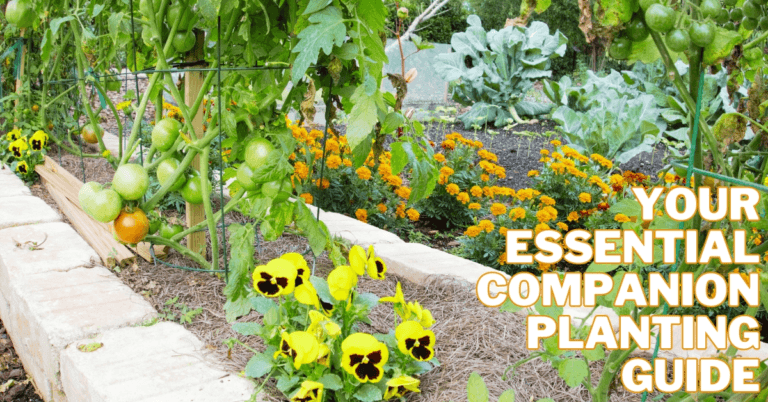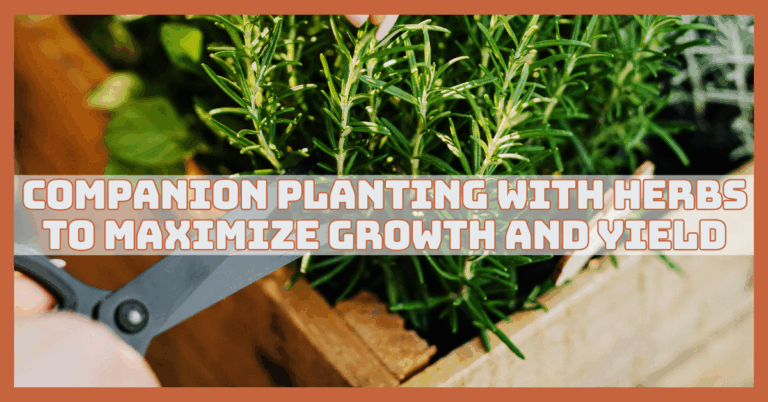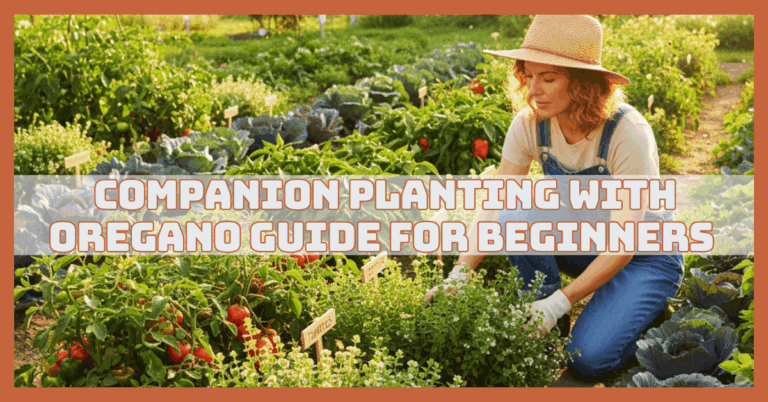Top 10 Companion Plants For Tomatoes
Top 10 Companion Plants For Tomatoes
Companion planting is a tried-and-true gardening method that pairs appropriate plants together to promote plant development, deter pests, and increase yields.
The partners you select might significantly influence your garden's tomato performance. Whether you're looking to ward off harmful insects, improve soil health, or encourage more vital, tastier tomatoes, companion plants are essential.
In this article, we'll explore the top 10 companion plants for tomatoes and how they can help you cultivate a thriving, productive vegetable garden.
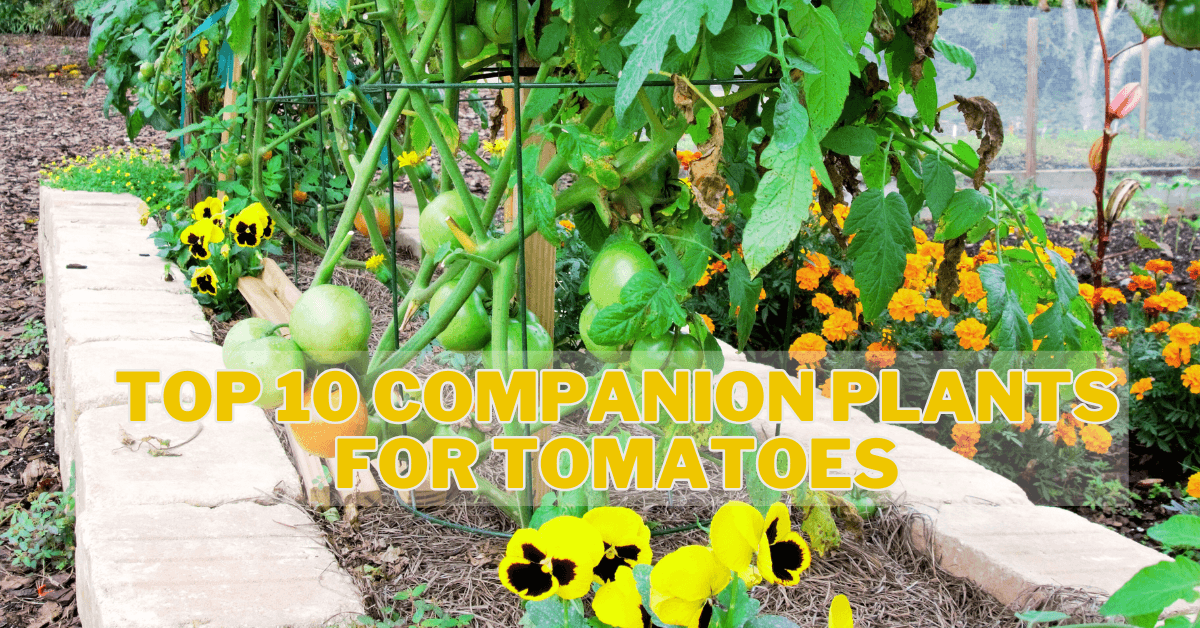
What Is Companion Planting?
Companion planting is a gardening practice in which several plants are cultivated near one another for mutual benefit. This method has been practised for centuries and is based on the idea that certain plants when grown in proximity, can boost growth, deter pests, improve soil fertility, and enhance flavour.
For example, some plants release natural chemicals that repel harmful insects, while others attract beneficial insects like pollinators or predatory bugs that keep pests in check.
Companion planting can also improve soil conditions. By fixing nitrogen in the soil, legumes like beans and peas improve the soil's fertility for nearby plants.
Additionally, certain plants may provide physical support, like using tall sunflowers to support climbing plants like beans.
Tomatoes, for instance, thrive when planted with companions like basil, which is said to improve their flavour and deter pests like aphids. Marigolds, another great companion, help repel nematodes and other soil-borne pests.
By carefully choosing plant combinations, gardeners may produce a more environmentally friendly, self-sufficient garden that encourages healthier, more productive plants while lowering the need for chemical pesticides and fertilizers.
Companion Plants For Tomatoes
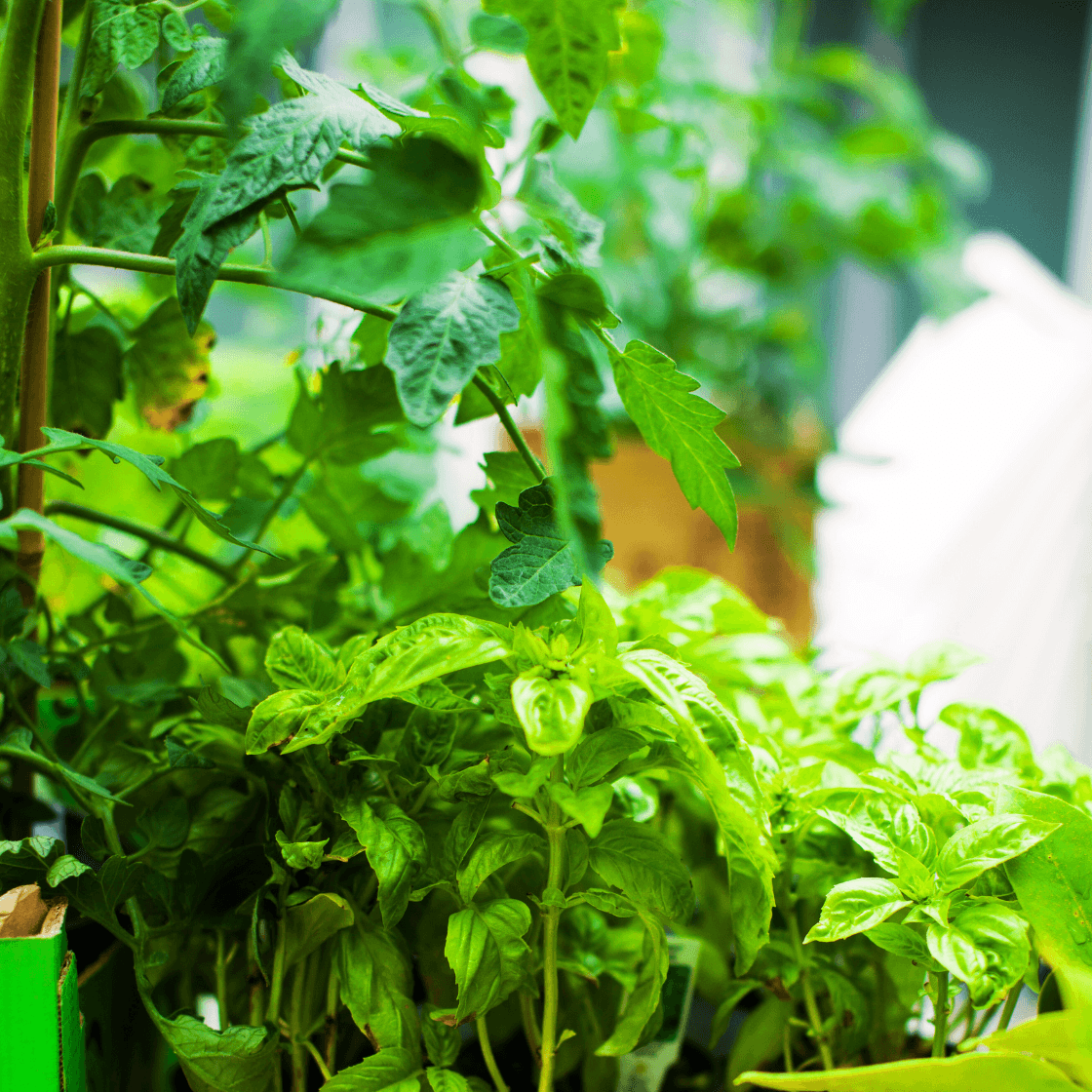
1. Basil: The Tomato’s Best Friend
Basil is among the most well-known friends of tomatoes. This aromatic herb improves flavour and is essential to the crop when combined with tomatoes.
Benefits Of Planting Basil With Tomatoes
Repels Pests
Basil helps repel tomato hornworms, aphids, and mosquitoes, acting as a natural defence for your garden. Its strong scent confuses pests, keeping them away from tomatoes and reducing the need for chemical pesticides.
Boosts Growth
Some gardeners believe that basil enhances tomato plant growth by improving yield. While the exact mechanism isn’t fully understood, basil’s presence may create a beneficial microclimate or promote healthier soil conditions around tomato plants.
Enhances Flavour
Basil is thought to enhance the flavour of tomatoes when grown nearby. Many gardeners report that tomatoes grown alongside basil taste richer and more aromatic, possibly due to the complementary nature of their chemical compounds.
How To Plant Basil With Tomatoes
Planting basil around the base of your tomato plants is one of the best companion plants for tomatoes. This creates a mutually beneficial relationship that enhances your garden's overall health while ensuring enough space for proper airflow to prevent fungal issues.
The basil benefits from partial shade from the higher tomato plants, which helps it flourish in hot climates. In addition to perhaps increasing the flavour and production of your tomato produce, basil's fragrant oils help ward against pests like tomato hornworms and aphids.
2. Marigolds: Nature’s Pesticide
Marigolds are a powerhouse for natural pest control, making them a perfect companion for tomatoes.
Benefits Of Planting Marigolds With Tomatoes
Repels Nematodes
French marigolds release natural compounds into the soil that repel nematodes, tiny pests that can damage tomato roots. By planting marigolds near tomatoes, you help protect the plants from these harmful, soil-dwelling parasites.
Attracts Beneficial Insects
Beneficial insects that prey on common tomato pests like aphids and whiteflies, such as parasitic wasps and ladybugs, are attracted to marigolds. These predatory insects help maintain a natural balance, reducing the need for chemical pest control.
How To Plant Marigolds With Tomatoes
Plant marigolds in the same garden bed as your tomatoes, strategically spacing them between the rows to create a natural defence system. Their vibrant blooms add visual appeal and help repel harmful nematodes from the soil.
Additionally, marigolds attract helpful insects that feed on tomatoes, such as aphids and whiteflies, parasitic wasps, and ladybugs.
This companion planting technique boosts your tomatoes' health while adding beauty and biodiversity to your garden, creating a more sustainable growing environment.
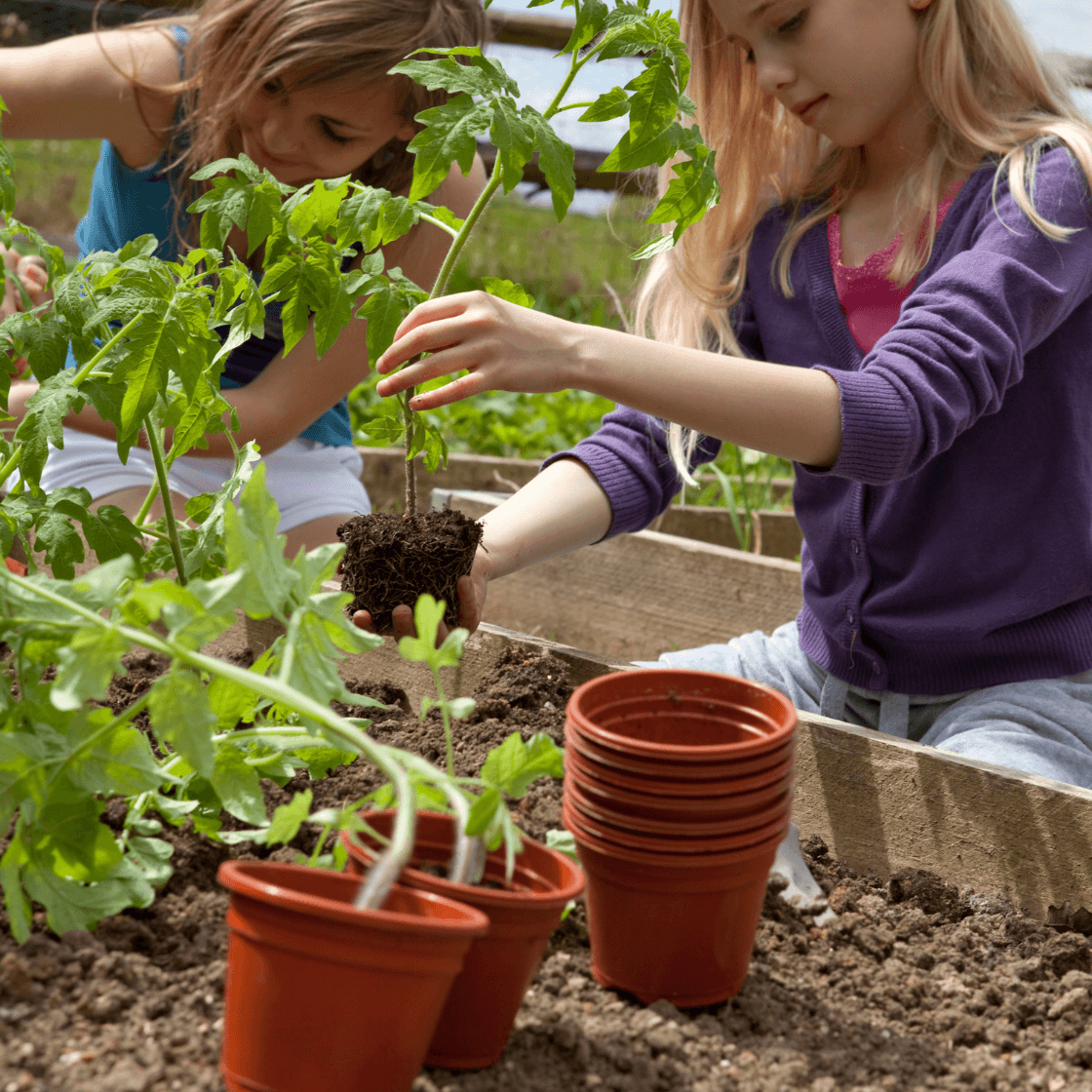
3. Garlic And Onions: Allium Allies
Garlic and onions are members of the allium family. They offer strong pest-repellent properties, making them valuable tomato companions.
Benefits Of Planting Garlic And Onions With Tomatoes
Repels Pests
Garlic and onions release a strong aroma that repels pests like aphids, spider mites, and rabbits. Their natural compounds act as a deterrent, helping to keep these harmful creatures away from tomato plants.
Disease Prevention
Garlic’s antifungal properties, such as blight, help prevent common fungal infections in tomatoes. When planted nearby, garlic’s natural defences can reduce the risk of diseases spreading, promoting healthier and more resilient tomato plants.
How To Plant Garlic And Onions With Tomatoes
Garlic and onion bulbs are excellent companion plants for tomatoes. They can easily be interspersed between your tomato plants or along the perimeter of the tomato bed without taking up much space. These compact plants don’t occupy much room, making them ideal companions for tight garden spaces.
While they grow, garlic and onions work as natural pest repellents, keeping aphids, spider mites, and rabbits at bay. Their antifungal properties also help prevent disease, protecting your tomato plants from blight and other fungal infections, all while adding versatility to your garden.
4. Carrots: A Hidden Helper
Carrots and tomatoes might seem unlikely, but they complement each other well in a garden setting.
Benefits Of Planting Carrots With Tomatoes
Improves Soil Health
Carrots’ long taproots naturally aerate the soil as they grow, improving oxygen flow and drainage. This benefits shallow-rooted tomato plants by promoting healthier root development and reducing the risk of soil compaction.
Space Maximization
Carrots grow underground while tomatoes grow above, allowing both to thrive without competing for space. This makes them perfect companions in small gardens, where efficient use of space is essential for maximizing yield.
How To Plant Carrots With Tomatoes
To maximize garden space effectively, sow carrot seeds directly beneath your tomato plants or along the edges of your tomato bed. As the carrot seedlings emerge, thin them out, providing adequate spacing for both plants to flourish.
This practice allows the tomatoes to access sunlight and nutrients without interference and ensures that the carrots have enough room to develop their long taproots. They create a vibrant, productive garden ecosystem while promoting healthy crop growth.
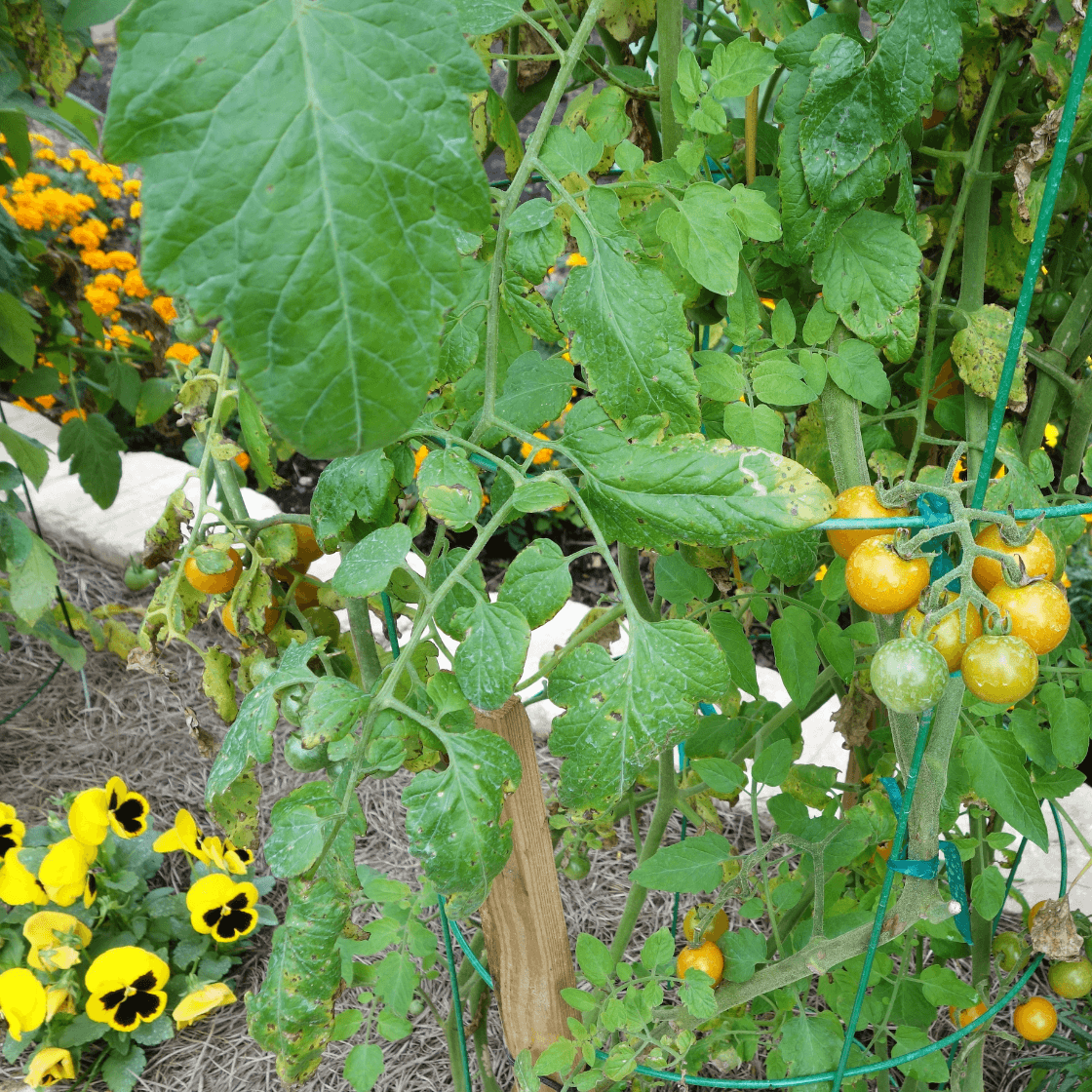
5. Nasturtiums: A Trap Crop
Nasturtiums are often planted near tomatoes as a “trap crop”—a plant that attracts pests away from the tomatoes themselves.
Benefits Of Planting Nasturtium With Tomatoes
Attracts Pests
Nasturtiums act as a trap crop by luring pests like aphids and whiteflies away from tomato plants. Nasturtiums help protect your valuable tomatoes from damage and infestations by drawing these harmful insects to themselves.
Edible Flowers
Besides their pest-control properties, nasturtiums produce vibrant, edible flowers that can enhance salads and other dishes. Their peppery flavour adds a delightful twist, making them a versatile and attractive addition to your garden and culinary creations.
How To Plant Nasturtiums With Tomatoes
To create a colourful, protective barrier, plant nasturtiums in hanging baskets nearby or along the edge of your tomato bed.
These low-maintenance flowers thrive in various conditions and attract pests away from your tomatoes. Their sprawling growth and colourful blooms add beauty to your garden while enhancing its ecological balance.
Nasturtiums will effectively trap aphids and whiteflies as they flourish, safeguarding your valuable tomato plants from infestations. This companion planting strategy allows you to enjoy a healthier, more productive garden with minimal effort.
6. Borage: A Bee Magnet
Borage is an ideal companion plant for tomatoes. Its beautiful, star-shaped flowers attract pollinators, enhancing overall garden health even though tomatoes are self-pollinating.
Benefits Of Planting Borage With Tomatoes
Attracts Pollinators
Borage is known for its vibrant blue flowers, which attract bees and other beneficial insects. By enhancing pollination, borage helps improve fruit set and yields across your entire garden, benefiting various plants.
Deters Tomato Worms
Borage is reputed to repel tomato hornworms, notorious pests that can cause significant damage to tomato plants. Its strong aroma and unique growth characteristics may deter these pests, helping to keep your tomatoes healthier and more productive.
How To Plant Borage With Tomatoes
Plant borage near your tomato plants, ensuring ample space for its growth as it can become quite large. This hardy herb features striking blue flowers and lush foliage, which can spread quickly in the garden.
Consider placing borage at the edges or designated corners in smaller gardens to prevent it from overshadowing your tomatoes.
By allowing it room to thrive, you'll enjoy its pollinator-attracting benefits and help maintain a balanced ecosystem that supports healthy tomato growth and overall garden vitality.
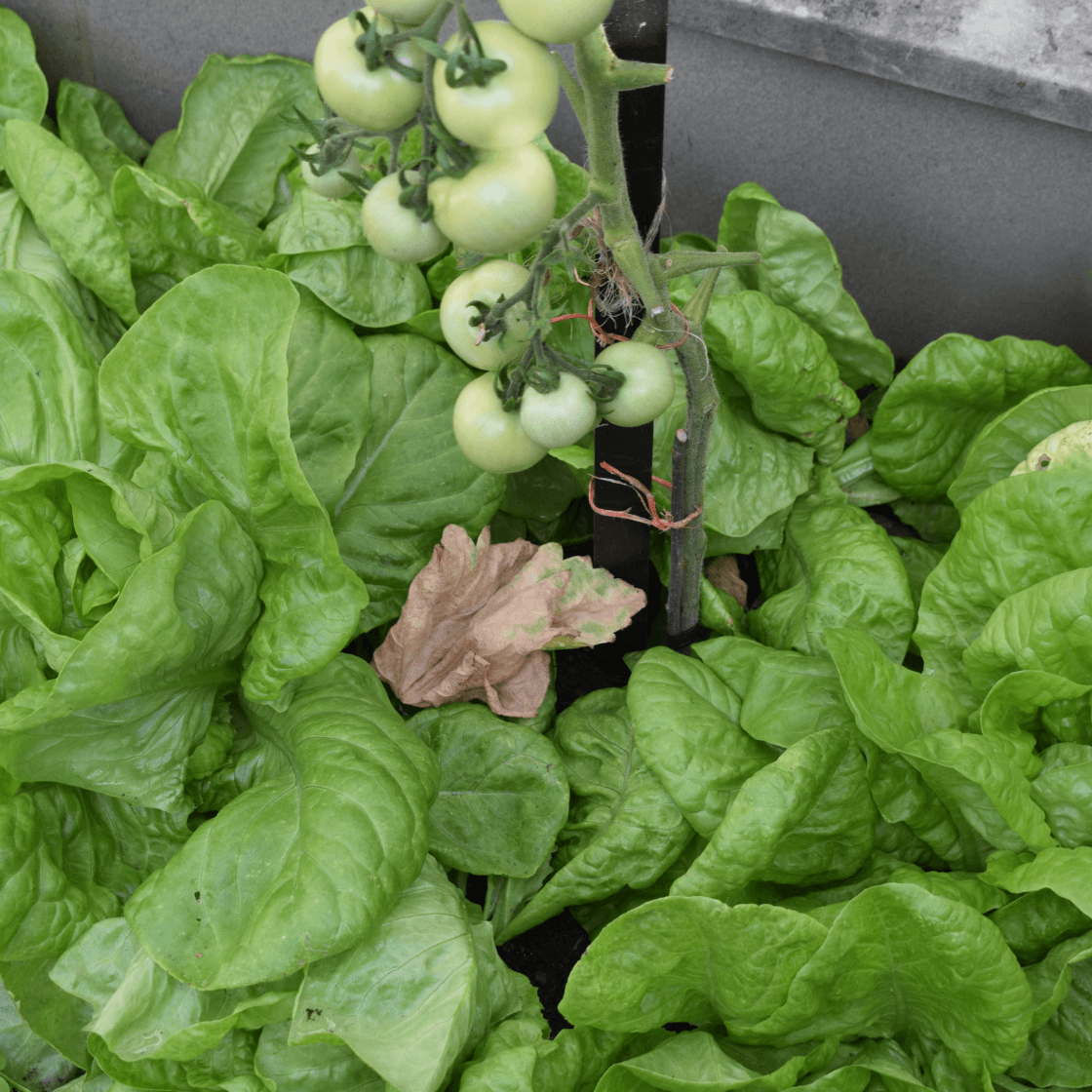
7. Lettuce And Spinach: Shade-Loving Companions
Lettuce and spinach can be excellent companions for tomatoes because they enjoy cooler, shaded conditions. As tomatoes grow taller, they can provide much-needed shade for these greens.
Benefits Of Planting Lettuce And Spinach With Tomatoes
Maximizes Garden Space
Lettuce and spinach grow rapidly and require minimal space, making them ideal companions for tomato plants. Interplanting these greens can efficiently utilize garden space, increasing yield without overcrowding your tomato plants.
Provides Ground Cover
Lettuce and spinach serve as an effective ground cover, creating a living mulch that helps retain soil moisture. Their foliage shades the soil, reducing evaporation and minimizing the need for frequent watering, promoting healthier plants in your garden.
How To Plant Lettuce And Spinach With Tomatoes
Lettuce and spinach are excellent companion plants for tomatoes. Planting them in the spaces between tomato plants maximizes your garden's potential, while the taller tomatoes provide shade, help regulate temperature, and prevent the greens from bolting in hot weather.
This shading effect allows the lettuce and spinach to thrive, producing tender, flavourful leaves throughout the growing season.
Additionally, leafy greens contribute to soil health by acting as natural mulch, helping retain moisture, suppressing weeds, and creating a harmonious and productive garden environment.
8. Cilantro: Pest Control With A Flavourful Twist
In the yard and the kitchen, cilantro is another herb that goes nicely with tomatoes.
Benefits Of Planting Cilantro With Tomatoes
Repels Pests
Cilantro emits a strong aroma that deters common tomato pests like spider mites and aphids. This organic pest-repelling ability helps keep tomato plants safe, as there is less need for chemical pesticides and better growth.
Attracts Beneficial Insects
When cilantro flowers, they become a magnet for predatory insects such as ladybugs and lacewings. In addition to improving the health of your tomato plants, these helpful insects also help maintain a balanced ecology in your garden by controlling destructive pest populations.
How To Plant Cilantro With Tomatoes
Plant cilantro near your tomato plants to enjoy its pest-repelling benefits while enhancing your garden's biodiversity. However, remember that cilantro has a brief growing season and will often bolt in warm temperatures.
Once it starts to flower, consider harvesting the leaves for culinary use or allowing them to bloom to attract beneficial insects.
These flowers will bring pollinators and predatory insects that help manage pest populations, creating a thriving, balanced ecosystem that supports healthy tomato growth in your garden.
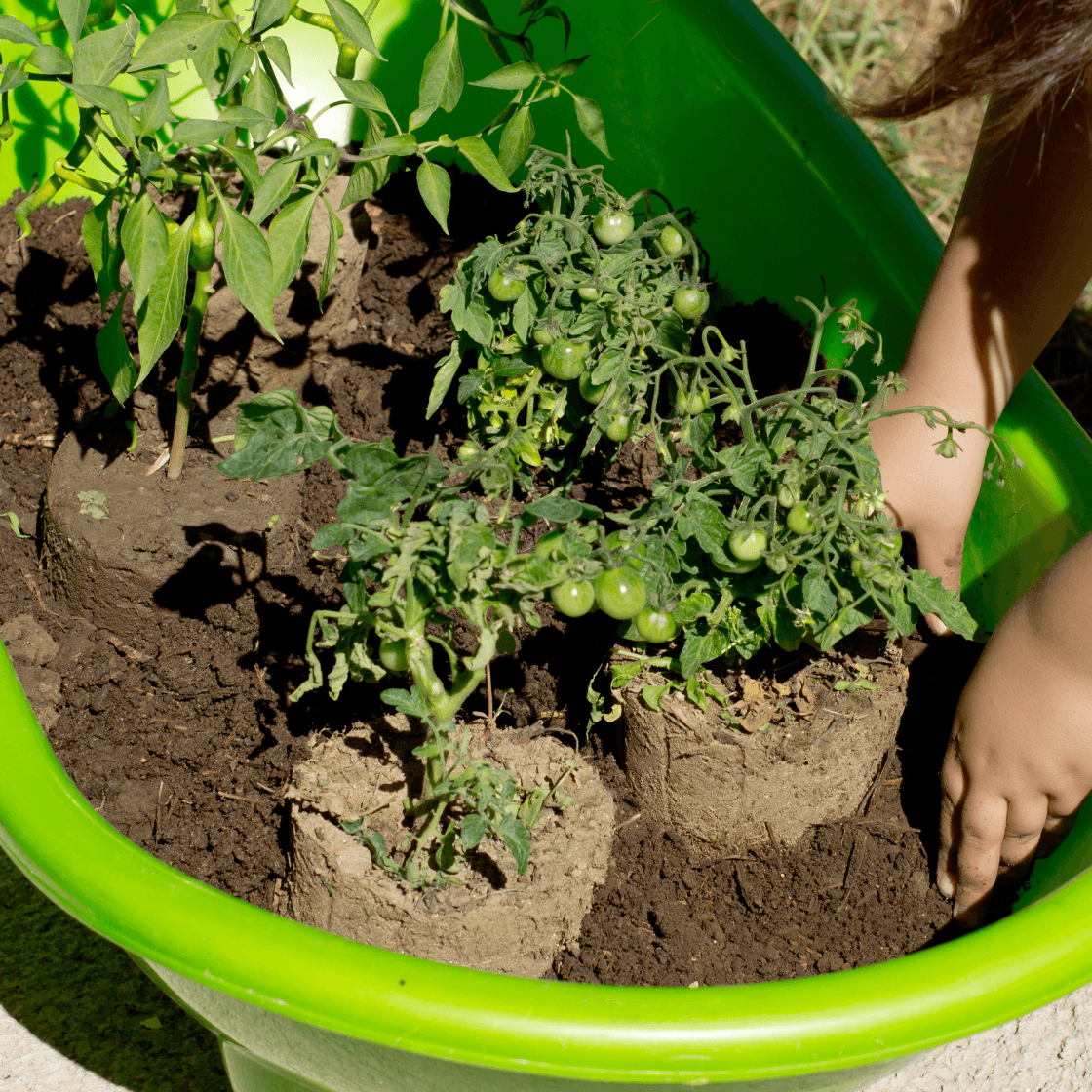
9. Peppers: A Shared Space
Peppers and tomatoes belong to the same plant family (Solanaceae) and grow under similar conditions, making them ideal companions.
Benefits Of Planting Peppers With Tomatoes
Maximizes Space
Peppers and tomatoes thrive under similar growing conditions, requiring comparable water and sunlight. Planting them together can efficiently utilize your garden space, maximizing yield without overcrowding other crops.
Pest Deterrent
Peppers have natural properties that can deter pests like aphids, which often target tomato plants. This companion planting strategy protects your tomatoes from infestations and contributes to a healthier overall garden ecosystem.
How To Plant Peppers With Tomatoes
Peppers make great companion plants for tomatoes when planted in alternating rows. This layout promotes a vibrant garden while ensuring sufficient spacing for proper airflow, essential for preventing diseases like powdery mildew.
This spacing allows both crops to access sunlight and nutrients effectively while reducing humidity around their leaves.
The peppers and tomatoes will complement each other as they grow, enhancing your garden’s overall health and productivity while creating an aesthetically pleasing and functional growing environment.
10. Thyme: A Low-Growing Protector
Thyme is a low-growing herb that makes an excellent ground cover around tomato plants.
Benefits Of Growing Thyme With Tomatoes
Repels Pests
Thyme emits a strong aroma that effectively repels common tomato pests, including whiteflies, cabbage worms, and aphids. This natural pest deterrent helps protect your tomato plants from infestations, promoting healthier growth and reducing chemical pesticide reliance.
Improves Soil Health
Thyme enhances soil quality by improving nutrient availability for nearby plants. Its deep root system helps aerate the soil, promoting better drainage and overall soil structure, which benefits tomato plants and encourages robust growth and productivity.
How To Plant Thyme With Tomatoes
Plant thyme around the base of your tomato plants or along the edges of your garden bed to create an effective companion planting arrangement.
Its low-growing habit allows it to thrive without competing for sunlight, ensuring that thyme and tomatoes receive the light they need.
Additionally, thyme's aromatic leaves help deter pests, providing a natural protective barrier. This arrangement maximizes space and enhances soil health, promoting a vibrant and productive garden ecosystem where both plants can thrive together.
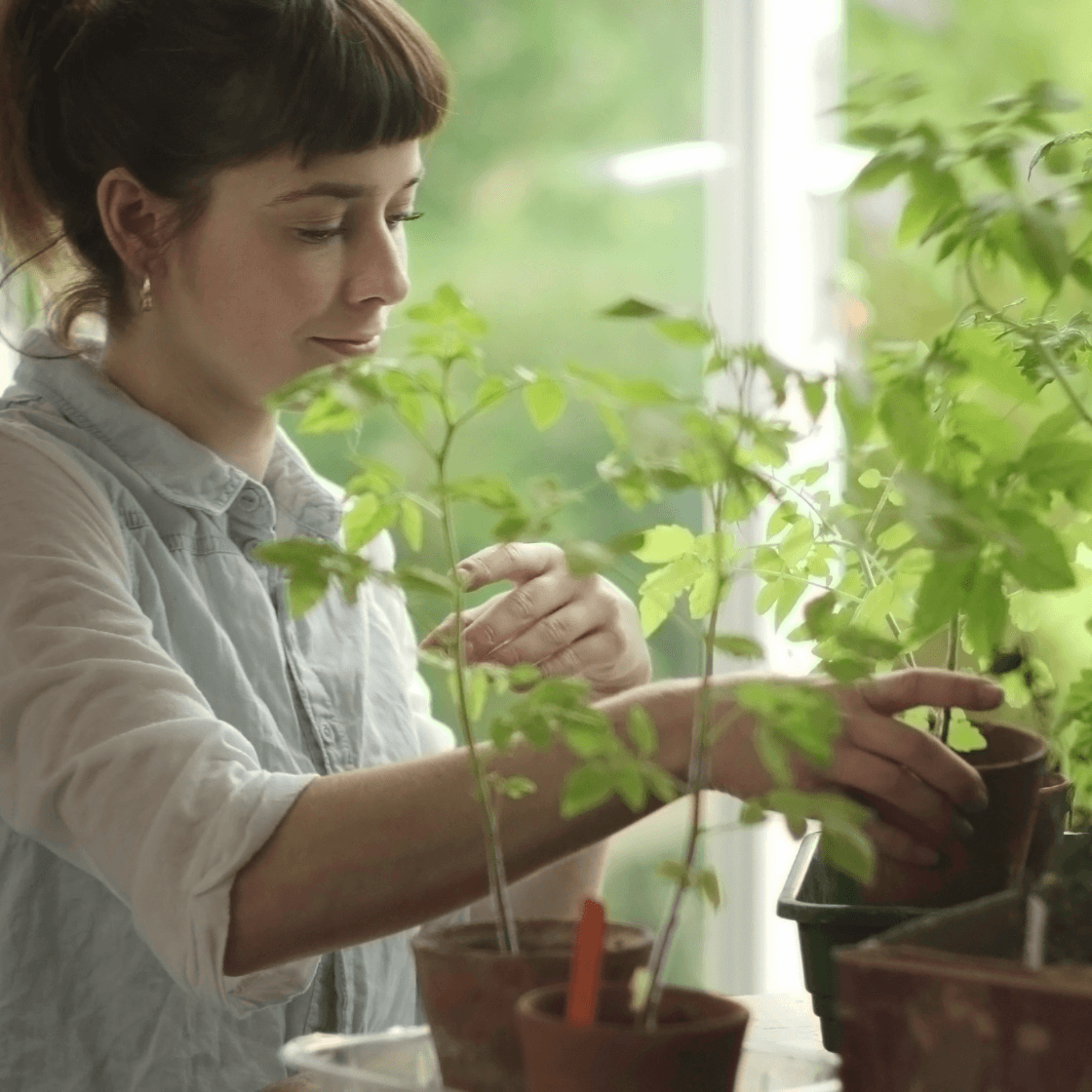
Plants To Avoid Near Tomatoes
When choosing companion plants for tomatoes, remember that not all plants are compatible; some can impede growth or attract pests. Avoid planting the following near your tomatoes:
1. Potatoes
Potatoes and tomatoes are members of the nightshade family and are prone to blight and other illnesses. Planting both crops together increases the chance of disease transmission, putting their health in danger.
2. Corn
Corn can attract pests, such as corn earworms, which may also target tomatoes. When planted near each other, these pests can infest both crops, leading to significant damage and reducing overall yields.
3. Eggplants
Like other nightshade family members, eggplants share disease vulnerabilities like tomatoes. Their combined presence can amplify the risk of fungal infections and pests, compromising the health of both plants.
4. Peppers
While peppers and tomatoes can sometimes thrive together, they share pests and diseases. If garden space is limited, it's wise to avoid proximity to prevent pest outbreaks affecting both types of plants.
5. Fennel
Fennel produces allelopathic compounds that inhibit tomato growth and negatively impact surrounding plants. Fennel and tomatoes should be kept apart to guarantee that both plants get the necessary nutrients to flourish.
6. Cabbage Family
Members of the cabbage family, including cabbage, broccoli, and cauliflower, can compete for nutrients and space with tomatoes. They also attract pests like cabbage worms, which can harm tomato plants.
7. Carrots
Although carrots can coexist with tomatoes, planting them too closely may stunt tomato growth. Adequate spacing is essential to ensure both crops can access necessary resources without interference.
8. Celery
Like carrots, celery competes for nutrients and space with tomato plants. This competition can negatively affect the vigour and yield of tomato plants, making them less productive when grown nearby.
9. Sage
Although sage is often regarded as a beneficial herb, its strong aroma can inhibit the growth of nearby tomatoes. It’s advisable to keep sage planted at a distance to promote healthy tomato development.
10. Alliums
While alliums, such as garlic and onions, are sometimes considered companion plants for tomatoes, their proximity can hinder tomato growth and compete for essential nutrients, negatively impacting overall development and productivity.
11. Chard
Swiss chard competes for nutrients and water with tomato plants, which can result in stunted growth. If you plan to plant leafy greens, choose varieties that won’t adversely affect your tomato crop.
Conclusion
Incorporating companion plants for tomatoes in your garden can significantly enhance growth, deter pests, and improve overall yield while providing protection and attracting beneficial insects for a successful and bountiful harvest.
These plants provide protection, improve soil health, and attract beneficial insects. Understanding the relationships between plants is key to a successful garden.
Adopt companion planting to increase your tomato plants' health and yield, guaranteeing a plentiful crop every season.
I trust you enjoyed this article on Top 10 Companion Plants For Tomatoes. Stay tuned for more blog posts soon. Take care!
JeannetteZ
>>>Please click here to read my all-inclusive article, About The Essential Companion Planting Guide<<<
>>>Please click here to read my all-inclusive article about Container Gardening<<<
>>>Are you interested in homegrown herbs and medicine? Please click here to find out more about it!<<<
Your Opinion Is Important To Me
Do you have thoughts, ideas, or questions? I would love to hear from you. Please leave me your questions, experiences, and remarks about this article, Top 10 Companion Plants For Tomatoes, in the comments section below. You can also email me at Jeannette@Close-To-Nature.org.
Disclosure
This post may contain affiliate links. As an Amazon Associate and other affiliate programs, I earn from qualifying purchases at no extra cost to you. Please read my full affiliate disclosure.
You might also enjoy these blog posts:
The Best Plants For Hydroponics And How To Grow Them
10 Winning Herb And Vegetable Companion Planting Combinations
Exploring Animal Communication: What Your Pet Is Trying To Tell You
Common Symptoms Of Stress In A Dog You Shouldn’t Ignore




